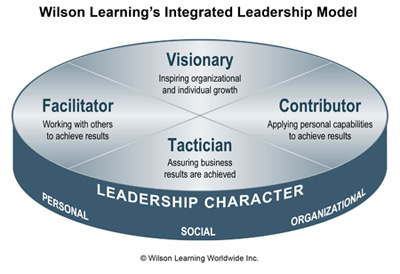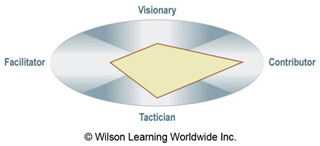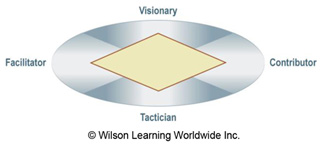A Leadership Development Approach
Integrating Essence and Form

In the 40 years that Wilson Learning has studied leadership and has helped its clients develop their approaches to leadership, we have come to believe that how leaders view their purpose will set the course for their organization's success. In this positioning white paper, we present our leadership point-of-view: that effective leadership is a balance of Essence and Form. We define how Essence and Form are expressed in leaders today, and show how different levels of leadership require different Forms, yet are all built on a common leadership Essence.
For Wilson Learning, the purpose of a leader is to engage others in committing their full energy to the creation of value and success. This simple statement contains some important elements that are at the core of our leadership point-of-view:
- To engage others: A key distinction between a leader and an individual contributor is the accomplishment of goals by engaging others. To achieve targeted business results, leaders need not only direct, but also inspire and harness others' talents toward an exciting vision.
- To commit their full energy: It is not enough for leaders to get compliance. A true leader generates a passion that fuels the highest level of commitment—so that employees are ready and willing to give all of their creativity, capacity, and knowledge to the organization, day in and day out. In return, employees receive what they need to grow, thrive, and gain professional fulfillment.
- To create value and success: Effective leaders know that to survive and grow, all stakeholders—customer, employees, and owners/stockholders—must obtain value from the organization. By having fulfilled employees, providing better products to customers, and assuring that owners/stockholders receive a fair return, effective leaders get everyone focused on growing value—growing both themselves and the organization.
From our 40 years of experience in leadership development, we know that leaders who have fulfilled this purpose—engaging others in committing their full energy to the creation of value and success—have successfully integrated the Essence and Form of effective leadership. Essence (the qualities that give leaders their identity) and Form (what a leader does and says) are the two sides of the leadership coin—the "being" and the "doing" of any leadership role.
Unfortunately, there are many leaders who fail to integrate Essence and Form. Most anyone can recall collaborating with a leader who was all Form and little Essence—a leader who got efficient action, but not impassioned commitment. These are the leaders who give the impression of expecting a lot from others, but not much from themselves—whose intent you did not know or trust and who, in short, got compliance but not commitment from their employees.
Most anyone can also recall working with a leader who was big on Essence but short on Form. These are leaders who generate a deep trust and commitment in others, but who lack the ability to focus that commitment in a single direction. In other words, they engender trust in their values, but not their competence.
Wilson Learning's approach to assessing and developing leaders was created with the intent of tapping both the Essence and Form of leadership. Essence is captured in what we call Leadership Character—those elements of leadership that are enduring and core to how people view the purpose of leadership. Form, in contrast, represents those elements of leadership that adapt and change, depending on a leader's level and functional role. While distinct, both aspects are essential to effective leadership.
Leadership Character: The Essence of Leadership
Many ineffective leaders aspire to a leadership position because of what they believe they will be empowered to do. In other words, they yearn for the power and authority to do things their own way. But our experience suggests that the most effective leaders begin their development by asking themselves not what they are empowered to do as a leader, but what kind of leader they want to be. It is this focus on the being of leadership—this self-awareness of the values and principles that these individuals bring to leadership—that Daniel Goleman describes in his book Emotional Intelligence (Bantam, 1997) as "twice as important as all other skills and factors" in leadership success. Wilson Learning refers to this as Leadership Character.
Leadership Character is comprised of values, characteristics, and clarity of purpose that determines what one wants to be as a leader. It is expressed in the consistency of behavior—the degree to which a leader's actions match his or her words. Most people have experienced, in either their work or personal lives, a leader who served as a role model for Leadership Character. It was that leader who demonstrated a true interest in you as a person, who mentored or supported you as you grew professionally, and who always seemed to make decisions based on a profound clarity of purpose and intent. It is this kind of leader to whom individuals are drawn and for whom a person is compelled to give maximum energy.
We have found that few organizations (or leaders) define the important elements of Leadership Character in the exact same way. In fact, our research has identified more than 16 individual character factors that have been linked to leadership success. Wilson Learning categorizes these into three principal components: Personal Character, Social Character, and Organizational Character.
- Personal Character. The character to stay steadfast and decisive in the face of adversity.
- Social Character. Showing others respect, being compassionate, and valuing individual differences.
- Organizational Character. The willingness to put the organization's and its customers' needs ahead of one's own personal needs.
Effective leaders demonstrate a balance of all three components as core values.
Leadership Character is the foundation, or Essence, of all effective leadership. It is also one of the least tangible aspects of leadership. Some believe that Leadership Character can't be developed—that people either have it or they don't. We believe that not only can people develop Leadership Character, but that they must do so if they aspire to improve leadership performance. In other words, you cannot develop the leader without developing the person. We also recognize that organizations do not develop Leadership Character in the same ways that they develop other leadership skills. Developing Leadership Character requires getting leaders to acknowledge their value systems, increase their self-awareness, experience the impact of character in their lives, and break old patterns of thinking. Through a combination of experiences, coaching, and support, one can create the reflection necessary to develop Leadership Character.
Four Roles: The Form of Leadership

While Leadership Character is the foundation of effective leadership, it alone is not sufficient. Unless this foundation is supplemented by the skills and knowledge required to execute on those values and principles, the leader fails to produce the tangible results necessary for creating organizational success.
Our perspective, based on both in-depth research and practical experience, is that the skills required to execute effective leadership can be defined as four core roles that each leader must fulfill: the Visionary, the Tactician, the Facilitator, and the Contributor.
These roles complement each other, bringing their own strengths to effective leadership. For example, the Visionary focuses on setting direction, while the Tactician ensures activity toward that vision. The Facilitator makes sure that all team members and stakeholders are appropriately involved, while the Contributor ensures that the leader's own talents are being applied. These four roles define the seemingly contradictory responsibilities of a leader—often the greatest challenge of leadership. Being a great leader means being able to effectively balance these four roles and successfully integrate them with Leadership Character.
Four Leadership Roles
| Visionary | Tactician | Facilitator | Contributor |
|---|---|---|---|
| Guiding organizational and individual growth through creation and communication of a compelling vision and strategy. | Ensuring that results are achieved by effectively planning work, delegating responsibility, reviewing performance, and improving systems and processes. | Creating an environment of collaboration and partnership to ensure effective working relationships. | Creating organizational success by contributing their personal talents, experiences, and abilities. |
| K E Y C O M P E T E N C I E S | |||
|
|
|
|
© Wilson Learning Worldwide Inc.
Different situations call for different types of leadership; therefore, the importance of each role varies by level and by organization. Yet all four roles are essential for effective leadership at all levels. A first-line supervisor may need to place more emphasis on the Tactician role, but cannot ignore the Visionary role. A chief executive officer will need to place more emphasis on the Visionary role, and less on the Contributor role, leaving most implementation issues to the executive team. However, there will still be important—and often times, critical—decisions to be made that require a CEO to draw on his or her Contributor skills. Effective leaders lead from the perspective of all four roles.
The Visionary. The Visionary guides organizational and individual growth through creation of a compelling vision. While important at all organizational levels, this visionary role assumes different forms as a leader's span of control broadens. Senior managers need to have a keen understanding of their competitive marketplace and then use that information to craft a vision and strategy for the organization. They also need to involve others in the refinement of that vision and share that vision in a way that promotes commitment to achieving it. Nevertheless, even first-line supervisors (at a minimum) will need to translate the organization's vision and strategy into meaningful work for his or her employees, and understand the needs of his or her internal customers.
The Tactician. If the Visionary asks, "What?" the Tactician asks, "How?" In the role of Tactician, the leader assures that business results are achieved through effective management of tasks and responsibilities. The effective Tactician plans work activities that are both achievable and challenging for the employee, appropriately delegates tasks, objectives, and decisions to others, monitors and reviews performance to ensure that organizational objectives are being met, and readily supports others' performance.
The Facilitator. The Facilitator creates an environment of collaboration and partnership to ensure effective working relationships—a key responsibility at every level of leadership. In the role of Facilitator, effective leaders deal with conflict, build teams, and apply communication skills to influence action and decisions. Fulfilling their role as Facilitator, the leader creates the environment where everyone feels valued and knows that they are making a contribution to the success of the organization.
The Contributor. Finally, the Contributor focuses on creating organizational success through the use of personal talents. While leaders may not typically be the doers, they are often called upon to use their creativity, problem-solving abilities, and decision-making skills. In particular, senior managers need to apply their knowledge and understanding of how decisions really get made in the organization.
Integrated Leadership: Performance with Fulfillment
Integrating the four roles—the Visionary, the Tactician, the Facilitator, and the Contributor—with the underlying foundation of Leadership Character creates the conditions necessary for achieving performance with fulfillment. We believe that both performance and fulfillment are essential to sustained high performance—that people will not achieve sustained high performance without feeling fulfilled, and that people will not feel fulfilled at work unless performing at high levels. Helping organizations and individuals achieve performance with fulfillment has been Wilson Learning's mission for more than 40 years. It encompasses everything we are about as an organization.
Integrated leadership creates the conditions necessary for performance with fulfillment. A leader's inability to assume any one of the four roles reduces fulfillment, performance, or both. Without vision, employees do not gain fulfillment from knowing that they are contributing to a greater good. Without tactical insight, employees find difficulty determining whether or not their actions are contributing to organizational success. Without facilitative direction, work environments can become hostile and unproductive. Without a sense of meaningful contribution from their leaders, employees lack role models of performance with fulfillment. And in the absence of Leadership Character, employees will sense a lack of reflective thinking or values in their leaders and will adjust their own personal level of commitment to organizational success accordingly.
Profiles of Leadership
All leaders, regardless of level, need to fulfill all four roles. But they do not need to emphasize all four roles at the same depth and to the same extent. The prominence of each role will vary, depending on the specific responsibilities of that leader. Plotting the importance of each leadership role on the graphic representation of the model illustrates how different leadership positions require different profiles to be effective. While there are probably an infinite number of possible profiles, below we define the three that are most common.

Performance Leadership. The Performance Leadership profile is a typical profile of a first-line supervisor or manager (e.g., sales managers, supervisors, accounting managers), although in some organizations, Performance Leadership is the core profile of department managers or even division leaders.
Performance Leadership requires strong Contributor and Tactician skills because of a leader's responsibility for tasks and objectives. Performance Leaders focus on ensuring that all employees are adding value and are often expected to have the answers to technical or functionally specific questions. While these managers will need to effectively translate organizational strategy into day-to-day workgroup objectives—and will occasionally have to lead team efforts—most of their time is spent on the tactical aspects of "getting the job done."

Growth Leadership. The Growth Leadership profile is the most balanced of all three types, representing a typical profile of a mid-level or division manager within a midsize to large organization.
Literally "stuck in the middle," Growth Leadership requires moderate to strong skills in all four leadership roles. Growth Leaders are expected to execute on strategy, even though they may not have been involved in the actual formation of that strategy. They often need to work with and influence peers over whom they have no authority and confront interpersonal conflict within the organization. Growth Leaders also require strong tactical skills as they manage other managers in accomplishing group objectives. They are also often called upon to contribute their unique talents to solving functionally specific problems or making critical decisions. Without a doubt, the manager with the Growth Leadership profile wears many hats.

Strategic Leadership. The Strategic Leadership profile is that of an executive-level leader (e.g., division vice president and above). The primary roles of the Strategic Leadership profile are Visionary and Facilitator, as these leaders are expected to drive change, create a vision for the organization's future, and develop strategies for achieving that vision. To accomplish this, Strategic Leaders need strong Facilitator skills to get diverse functions and employee groups working together toward a shared positive future.
The Tactician skills inherent to this profile are usually limited to supporting functional managers' tactical leadership efforts, whereas Contributor skills are typically reserved for more critical situations. Executive-level leaders who spend a lot of time in Tactician and Contributor modes are not viewed as being effective in the executive role because they clearly have not sufficiently developed their next line of managers.
Integration of Essence and Form
We believe that, unlike the four roles of leadership, Leadership Character is equally emphasized regardless of where, or at what level, a leader works. Leadership Character may be expressed differently, depending on a leader's position, the organization's values, and even the specific business the organization faces. But it is not the case that Character is more critical as you move toward higher levels of leadership. This is because people need a leader who is clearly grounded in what he or she stands for as a leader—especially in times of change. With so many factors disrupting the work environment today, leaders with a well-developed sense of self can provide that beacon of stability—the consistency of purpose and values that employees need to remain focused and on task, regardless of the level in the organization.
In the end, effective leadership is about both Essence and Form—a clarity of purpose for what one wants to be as a leader, and the ability to execute the roles of the Visionary, the Tactician, the Facilitator, and the Contributor. Only through this integration of Essence and Form can a leader effectively engage others in fully committing their energy, creativity, and talents. Today's business climate requires leaders who are role models for this integration—leaders who express an excitement about the possibilities of leadership. To them, leadership is being of service to others. And despite the many challenges they face, effective leaders exude a profound energy, a contagious excitement, and an undying hope about the future that is inspiring to everyone around them.
To learn more, contact Wilson Learning at 1.800.328.7937 or complete the online form.






 Please complete this form to download A Leadership Development Approach | Integrating Essence and Form.
Please complete this form to download A Leadership Development Approach | Integrating Essence and Form.



